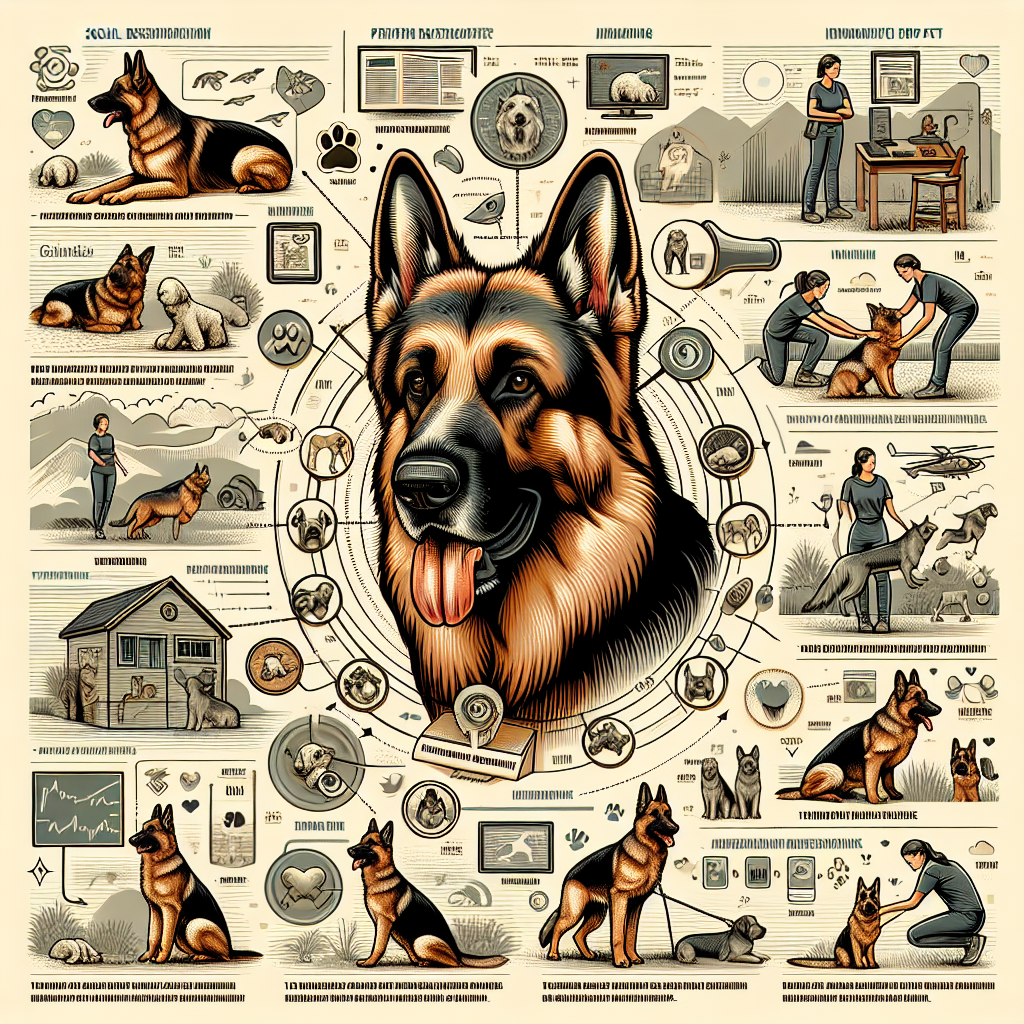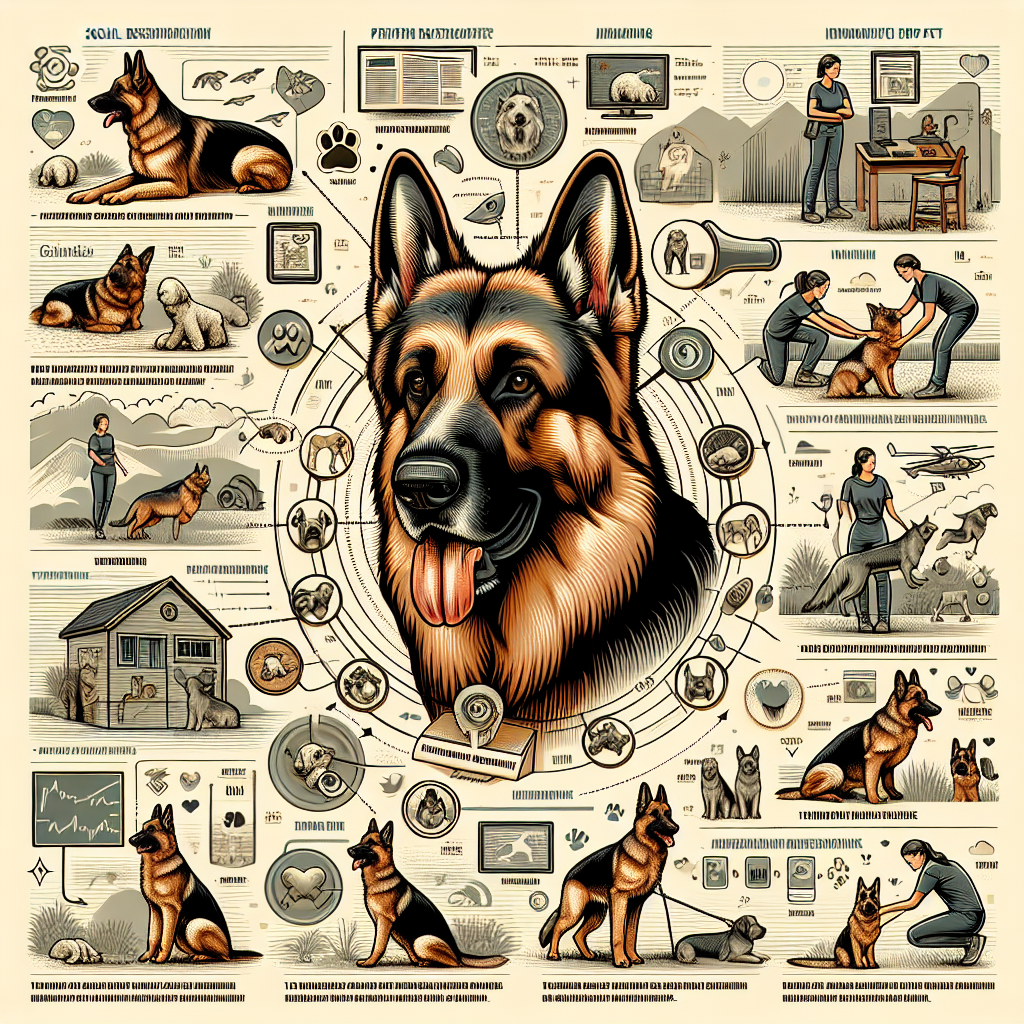German Shepherds: a beloved breed known for their intelligence, loyalty, and protective nature. But when it comes to their interaction with other pets, the question arises: are German Shepherds good with other animals? Whether you have a feisty feline or a fluffy bunny, it’s important to understand the temperament and compatibility of this majestic breed. In this article, we will explore how German Shepherds typically behave around other pets, providing insights into their potential as companions for your furry, scaly, or feathered friends. So, let’s discover if this iconic breed can create harmonious relationships within your multi-pet household.
Personality and temperament
German Shepherds are known for their intelligence, loyalty, and protective nature. They have a strong drive to please their owners and are highly trainable. This makes them a popular choice for various roles, including police or service dogs. However, it is essential to understand their personality and temperament when considering their compatibility with other pets.
Trainability
German Shepherds are highly trainable due to their intelligence and eagerness to learn. They respond well to positive reinforcement training methods and thrive when given mental stimulation and consistent guidance. It is crucial to focus on their socialization from a young age to ensure they can peacefully coexist with other pets.
Protectiveness
German Shepherds have a natural protective instinct, making them excellent guard dogs. While this trait can be beneficial in certain situations, it may require careful management when introducing them to other pets. Proper socialization and training play a vital role in ensuring their protectiveness does not translate into aggression towards other animals.
Socialization
Socialization is the key to introducing German Shepherds to other pets successfully. Early and ongoing socialization exposes them to various environments, people, and animals, helping them develop positive associations and acceptable behavior. Through gradual exposure and positive experiences, German Shepherds can learn to coexist peacefully and respectfully with other pets.
German Shepherds and dogs
Compatibility with other dogs
German Shepherds can generally get along well with other dogs, especially when they have been adequately socialized from a young age. Their compatibility may depend on factors such as gender, individual personalities, and the dogs’ previous experiences. It is important to evaluate each dog’s temperament and introduce them gradually while closely monitoring their interactions.
Introducing a German Shepherd to a new dog
When introducing a German Shepherd to a new dog, it is important to do so in a controlled and supervised environment. Begin with short, positive interactions while closely observing their body language. Monitor for signs of tension or aggression, such as raised hackles, growling, or stiff body posture. Gradually increase the duration of their interactions while ensuring a positive and calm atmosphere.
Training and socialization for German Shepherds and dogs
Training and socialization play a crucial role in ensuring a healthy dynamic between German Shepherds and other dogs. Regular obedience training, including commands like “sit,” “stay,” and “leave it,” can help establish boundaries and prevent potential conflicts. Additionally, frequent exposure to various social situations and other well-behaved dogs can further enhance their social skills and adaptability.
German Shepherds and cats
Introducing a German Shepherd to a cat
Introducing a German Shepherd to a cat requires patience and careful management. Begin by allowing them to become familiar with each other’s scents. Gradually introduce them in controlled interactions, using physical barriers like baby gates or crates initially. Observe their behavior, and if there are signs of aggression or excessive prey drive, consult a professional trainer or behaviorist for guidance.
Supervision and management
Supervision is crucial when German Shepherds and cats are in the presence of each other, especially during the initial stages of their introduction. Keep them separated when unsupervised to prevent any potential harm. Consider utilizing secure pet gates or designated safe areas where the cat can retreat if needed. Positive reinforcement training can also help reinforce calm behavior around the cat.
Training and socialization for German Shepherds and cats
Training German Shepherds to coexist peacefully with cats primarily involves teaching them impulse control and positive association. Basic obedience training, focusing on commands like “leave it” and “stay,” can help redirect their attention away from the cat. Gradual introduction to cats in controlled settings, rewarding calm behavior, and using positive reinforcement techniques such as clicker training can aid in their socialization.

German Shepherds and small pets
Prey drive
German Shepherds have a natural prey drive, which can pose a challenge when introducing them to small pets like hamsters or guinea pigs. Their instinctual urge to chase and potentially harm smaller animals requires careful management to ensure the safety of both the German Shepherd and the small pet.
Introducing a German Shepherd to small pets
When introducing a German Shepherd to small pets, it is crucial to create a secure environment that prevents direct contact between them. Utilize sturdy enclosures or cages for the small pets to ensure their safety. Gradual exposure, under close supervision, can help desensitize the German Shepherd to the presence of small animals.
Training and management for German Shepherds and small pets
Training German Shepherds to coexist with small pets involves teaching them a strong “leave it” command and reinforcing positive behavior around the small pets. Additionally, providing mental stimulation and physical exercise can help channel their energy in a constructive manner, reducing the likelihood of a high prey drive. Consistent management and supervised interactions are key to their successful cohabitation.
German Shepherds and birds
Prey instinct
The prey instinct in German Shepherds can pose a significant risk to pet birds. Their natural inclination to chase, capture, and potentially harm birds makes it crucial to approach their interactions with birds with extreme caution and consider the safety of both pets.
Supervision and training
When German Shepherds and birds are in the same vicinity, constant supervision is necessary. Physical barriers, such as secure cages or separate rooms, can prevent direct contact and potential harm. Training a reliable recall command and providing ample mental and physical stimulation can help divert their attention from the birds and reduce the risk of chasing.
Creating a safe environment
Creating a safe environment is paramount when having German Shepherds and pet birds in the same household. Secure bird cages should be placed in areas inaccessible to the German Shepherd. Ensure the bird cages are sturdy and designed to withstand potential disruptions caused by an excited or curious dog. Regular training and consistent management help promote a harmonious coexistence.
German Shepherds and rodents
Predatory behavior
German Shepherds have a natural predatory behavior that can pose a risk to small rodents such as mice or gerbils. Their high prey drive may make it challenging to safely introduce them to rodents, requiring careful management and consideration.
Safety measures
When it comes to German Shepherds and rodents, it is best to keep them entirely separated. The size difference and the German Shepherd’s natural instinct to chase and potentially harm smaller animals make direct contact unsafe. Ensure that rodent enclosures or habitats are secure and placed in areas inaccessible to the German Shepherd.
Training and socialization for German Shepherds and rodents
It is not recommended to directly expose German Shepherds to rodents due to their prey drive. Instead, focus on redirection and alternative activities that fulfill their need for mental and physical stimulation. Basic obedience training can help establish boundaries and reinforce the “leave it” command. Consulting with a professional trainer or behaviorist can provide additional guidance tailored to the specific needs of the individual dog.
German Shepherds and rabbits
Instinctual behavior
The instinctual behavior of German Shepherds may make it challenging to introduce them to rabbits. Their natural prey drive and tendency to chase smaller animals necessitate caution when considering their compatibility.
Introducing a German Shepherd to a rabbit
Introducing a German Shepherd to a rabbit requires careful planning and management. Physical barriers, such as baby gates or crates, can be utilized initially. Allow them to become familiar with each other’s scent before gradually introducing controlled interactions. Consultation with a professional trainer or behaviorist is recommended to ensure the safety of both pets.
Training and management for German Shepherds and rabbits
Training German Shepherds to coexist with rabbits mainly involves teaching impulse control, a reliable recall command, and reinforcing calm behavior. Obedience training and positive reinforcement techniques can help redirect their attention away from the rabbit. Always supervise interactions closely and ensure the rabbit has a safe space to retreat if needed.
German Shepherds and reptiles
Predatory instincts
German Shepherds have a natural predatory instinct that may make introducing them to reptiles challenging. Their instinctual drive to chase and potentially harm small, moving creatures necessitates careful consideration and management.
Safety precautions
When it comes to German Shepherds and reptiles, it is best to keep them in separate areas. Ensure reptile enclosures are secure and placed in locations that the German Shepherd cannot access. Physical barriers, such as sturdy enclosures, can prevent accidental contact between the German Shepherd and the reptile.
Training and socialization for German Shepherds and reptiles
Direct interaction between German Shepherds and reptiles is not recommended due to the risk it poses to both pets. Training should focus on obedience and impulse control, reinforcing the “leave it” command in the presence of the reptile. Consult with a professional trainer or behaviorist for specialized guidance and recommendations.
German Shepherds and fish
Limited interaction
German Shepherds and fish typically have limited direct interaction due to their different environments. However, it is still important to ensure the safety and well-being of both pets.
Securing fish tanks
If you have an aquarium or fish tank, it is crucial to secure it to prevent any accidental tipping or damage caused by the German Shepherd’s curiosity or exuberance. Ensure that the tank is placed in an area inaccessible to the dog or utilize physical barriers such as gates or aquarium stands.
Training and management for German Shepherds and fish
Training German Shepherds concerning fish primarily involves teaching them to ignore the aquarium and reinforcing calm behavior around it. It is important to address any undesired attention or behavior towards the fish with redirection and positive reinforcement training. Providing ample physical exercise and mental stimulation also helps redirect their energy towards appropriate outlets.
Age and socialization
Early socialization
Early socialization is crucial for German Shepherds to develop positive relationships with other pets. Introduce them to a variety of animals, environments, and people during their critical socialization period, which is typically between 3 to 14 weeks of age. Positive experiences during this stage help shape their behavior and attitude towards other pets.
Adopting an adult German Shepherd
When adopting an adult German Shepherd, their previous experiences and socialization history may influence their compatibility with other pets. It is important to gather information about their background and temperament from the rescue or previous owners. Slow, gradual introductions and professional guidance may be necessary to ensure a smooth transition and successful integration with other household pets.
Gradual introductions
Regardless of age, gradual introductions are essential when bringing a German Shepherd into a household with existing pets. Taking the time to introduce them in controlled environments while closely monitoring their behavior allows them to form positive associations and familiarize themselves with each other’s presence. Patience, consistency, and positive reinforcement are key throughout the introduction process.
In conclusion, while German Shepherds have a strong protective instinct and prey drive, their compatibility with other pets is possible with proper socialization, training, and management. Early socialization, gradual introductions, and a calm, positive environment contribute to fostering harmonious relationships. Consulting with professionals, such as trainers or behaviorists, can provide valuable guidance tailored to individual circumstances, ensuring the safety and well-being of all pets involved.

